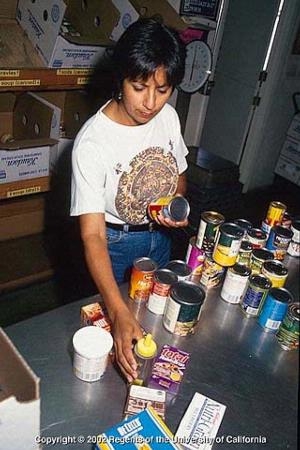The warmth and joy of the holidays often stirs the giving spirit, boosting donations to food banks. All contributions are welcome, of course, but food donors can add extra value to their gifts by making careful choices when scouring the pantry or grocery store for food contributions, say UC Cooperative Extension nutrition educators.

“People who get help from food banks are often at risk for health issues. Elderly recipients might suffer from chronic health problems, like heart disease or diabetes. Younger clients might suffer from obesity or overweight,” said Dorothy Smith, UC Cooperative Extension nutrition, family and consumer sciences advisor. “It’s important that they get the best quality nutrition possible.”
Lucia Kaiser, UC Cooperative Extension specialist in the Department of Nutrition at UC Davis, suggests donors select basic foods that can be used across ethnic groups, with an eye toward good health.
Rather than packaged ramen noodles or noodle-soup cups, which are high in fat and salt, she suggests bagged pasta with no added salt, whole grain, if possible. Give canned fruit in light syrup or in its own juice, rather than heavy syrup, to reduce sugar content. Instead of sugar-sweetened breakfast cereals, pick cereal that is low in sugar and high in fiber. Canned 100 percent juice is preferred over fruit punches.
Though some families might prefer bags of uncooked beans, rice and lentils, there are other recipients who have no idea how to prepare them. In addition, some food bank clientele are homeless and may have limited access to storage space and refrigeration. For recipients in this situation, easy-to-prepare and ready-to-eat foods would be most helpful.
Consider giving pop-top cans of stew, chili and soup, shelf-stable milk and cheese, and convenience foods like granola bars, packaged sandwich crackers, beef jerky and single-serving packages of nuts.
Providing healthful ethnic food staples is a way to support programs that serve families who prefer foods with a Latino or Asian flavor.
Lucrecia Farfan-Ramirez, UCCE nutrition, family and consumer sciences advisor in Alameda County, said donations of canned vegetables that meet the needs of Latino families include chili peppers, tomato products, corn, olives, hominy and nopales (cactus pads). Other staples used often in Latino households are long-grain rice, vermicelli, oatmeal, dry pinto beans and lentils, corn meal, masa and harina. Food banks that distribute fresh products to Latino families would also welcome fresh potatoes, onions, garlic, chayote and cabbage.
UCCE nutrition educator Sua Vang works with low-income families of Southeast Asian descent in Fresno County. She said donations of rice and canned oriental vegetables, such as bamboo shoots, mushrooms and baby corn, would be most welcome.
Other considerations for food bank donations:
- Check the “best by” or expiration dates on food donations you glean from the home pantry. Food banks cannot use anything that is old or expired.
- Don’t forget to look in the backyard for donations. Many Californians have citrus trees full of nutritious fruit. Mandarins, grapefruit, navel oranges and lemons are all ready to eat in the winter.
- Food banks also look for healthy donations after the New Year. Smith said they are often inundated with junk food in January when people clean their cupboards to comply with their own healthy eating resolutions. “Certainly, families that rely on food banks deserve treats and any donation is appreciated,” Smith said. “But to be of the greatest help, choose foods that are as healthy as possible.”
- Many food banks publish a donation “wish list” on their websites, which outlines needs specific to the populations they serve. Or, use the list below, which Smith compiled to help ensure healthy holidays for the hungry.
Dorothy Smith’s food bank gift list
Dairy
- infant formula
- nonfat dry milk
- evaporated milk
- instant breakfast drinks
- small boxes of shelf-stable (UHT) milk
- canned and boxed pudding
Protein foods
- canned tuna
- canned chicken
- canned beef stews
- canned salmon
- canned or dried beans
- baked beans
- canned chili
- peanut butter
- canned nuts
- bean soups
Vegetables
- canned vegetables
- vegetable soup
- canned tomato products
- spaghetti sauce
- baby-food vegetables
- V-8 juice
Fruit
- canned fruit
- raisins
- applesauce
- dried fruits
- baby-food fruit
- fruit leather (100% fruit)
- canned and boxed 100% juice
Grains
- rice and rice mixes
- canned pastas
- noodle mixes
- dry noodles and pastas
- macaroni and cheese mix
- cold cereals
- bran cereal
- shredded wheat
- infant cereal
- hot cereal mixes
- oatmeal
- bread and muffin mixes
- pancake mix
- whole-grain crackers
- granola bars
- graham crackers
- flour
- bread
Oils and condiments
- vegetable oil
- salad dressing
- syrup
- jelly and jam
- honey
- sugar
- mayonnaise
Extras
- tea
- coffee
- spices
Paper products
- toilet paper
- paper towels
- napkins
- tissues
- disposable diapers
Soap products
- hand soap
- laundry and dish detergent
- cleaning products
Personal care products
- shampoo
- toothpaste
- toothbrushes
- shaving cream
- razors
- deodorant